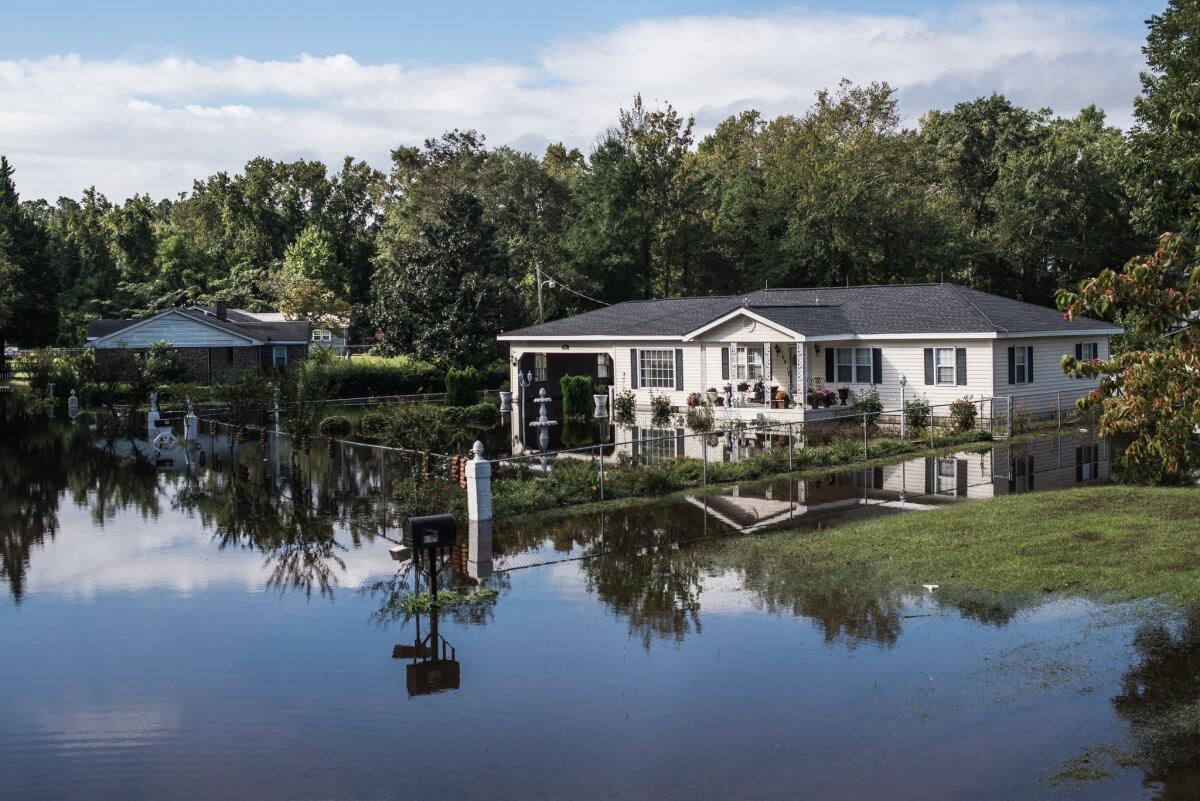Emergency repair orders issued for 75 private dams in South Carolina

A home in Georgetown, S.C., is inundated by floodwaters from the Black River. Now the state is calling on property owners and homeowner associations to submit repair plans for unsafe dams.
- Share via
reporting from ARCADIA LAKES, S.C. — After a historic rainfall flooded homes across South Carolina, the lake where Frank Lee planned to spend his retirement — paddling his kayak and fishing for bream — has vanished.
From his brick patio, all he can see is a puddle of mud and a small creek surrounded by a circle of homes that may soon face the challenge of raising as much as $1.5 million to fix the dam and restore the lake.
“It isn’t pretty, is it?” said Lee, 80, a retired insurance executive, as he gazed at the brown silt bed of Cary Lake, a 56-acre private pond whose dam overtopped early this month, flooding this tiny suburban community northeast of Columbia.
“It’s a tall order for 46 homeowners, many elderly and on Social Security, to come up with more than a million dollars,” he said. “I don’t know where the funding will come from.”
With South Carolina still reeling from the destruction caused by the 1,000-year flood, many homeowners are now under emergency orders to drain small ponds and lakes and rebuild unsafe dams. The state Department of Health and Environmental Control has issued 75 emergency orders, calling on property owners and homeowner associations across the state to submit repair plans.
Many who own property by the water — some of whom are already struggling to rebuild damaged homes — are uncertain how, or even whether, they will restore their ponds and lakes. Experts estimate that it could cost $200,000 to $2 million to rebuild many of the dams to meet current safety standards.
After the Oct. 4 flood, when Hurricane Joaquin-fueled storms dropped as much as 20 inches of rain, few dispute that failed or compromised dams could pose a threat to residents downstream. The question is who is responsible, and who is prepared to pay, for rebuilding these small earthen dams, some of which were built more than a century ago.
Some areas, such as Arcadia Lakes, are calling for federal money to repair the dams, arguing that the private lakes perform a public service by controlling storm water runoff or even supporting public roads. Without the lakes, they argue, the property values of “lakeside” homes are likely to plummet, affecting property taxes and basic municipal services.
“Arcadia Lakes without the lakes is not Arcadia Lakes,” said the town’s mayor, Mark Huguley, noting that the city’s motto is “Seven Lakes, One Town.”
Yet the prospect of state or federal assistance for private owners of dams is uncertain in the fiscally conservative Southern state. In 2013, four of South Carolina’s seven House representatives and both U.S. senators voted against a $51-billion emergency aid package for victims of Hurricane Sandy.
The state House budget committee will meet next week to assess the impact of flooding and potential recovery costs.
Since the flooding, South Carolina has faced heavy criticism for its lax dam safety inspection program, one of the nation’s most poorly funded. Of the more than 2,400 state-regulated dams, most of which are earthen dams on private property, 180 were deemed high-hazard potential, according to the Assn. of State Dam Safety Officials, a nonprofit organization.
NEWSLETTER: Get the day’s top headlines from Times Editor Davan Maharaj >>
Much of the water damage has taken place along the Gills Creek watershed, a 70-mile-long network of streams, ponds and lakes that weaves through the cities of Arcadia Lakes, Forest Acres and Columbia. Beginning in the early 1900s, earthen dams were built to create recreational lakes, and in recent decades, neighborhoods have grown up around the scenic waterways.
As pressure mounts to improve dam safety, some homeowners complain that they have not been given enough time to comply with the state’s emergency orders.
If a homeowner does not lower his or her lake, state officials will hire a contractor to implement the order, charging the cost to the dam owner. Violating the order also could result in a $1,000 fine and, if criminal charges for noncompliance are successfully pursued, penalties of up to $500 a day.
Ashley Bryant Noojin, a clinical psychologist who owns a small, six-acre pond in Eastover, southeast of Columbia, said the state gave her only a few days’ notice to drain her pond, even though her dam had no mechanism to control the water. After an engineer she hired submitted a report to the state agency this week, she was informed he was not adequately certified. Two days later, a state official warned her that she would be subject to penalties if she did not comply.
“The expectations are nearly impossible for private homeowners to meet,” she said. “I’m just one person who happens to own a dam and I’ve not got an endless bank account.”
Yet amid all the confusion, some communities are confident they can repair their dams.
At Cary Lake, where a rush of water from Jackson Creek wrought more lasting damage — overtopping the dam, breaching it, and wiping out a public roadway — Anita Owens, 84, a retiree who has lived on the lake for decades, remembered how homeowners chipped in to repair the dam in 1987, after a breach caused by heavy rainfall.
“I’m not worried,” she said. “We can’t spend a whole lot of money on houses on the lake and not rebuild the dam.”
Jarvie is a special correspondent.
More to Read
Sign up for Essential California
The most important California stories and recommendations in your inbox every morning.
You may occasionally receive promotional content from the Los Angeles Times.











